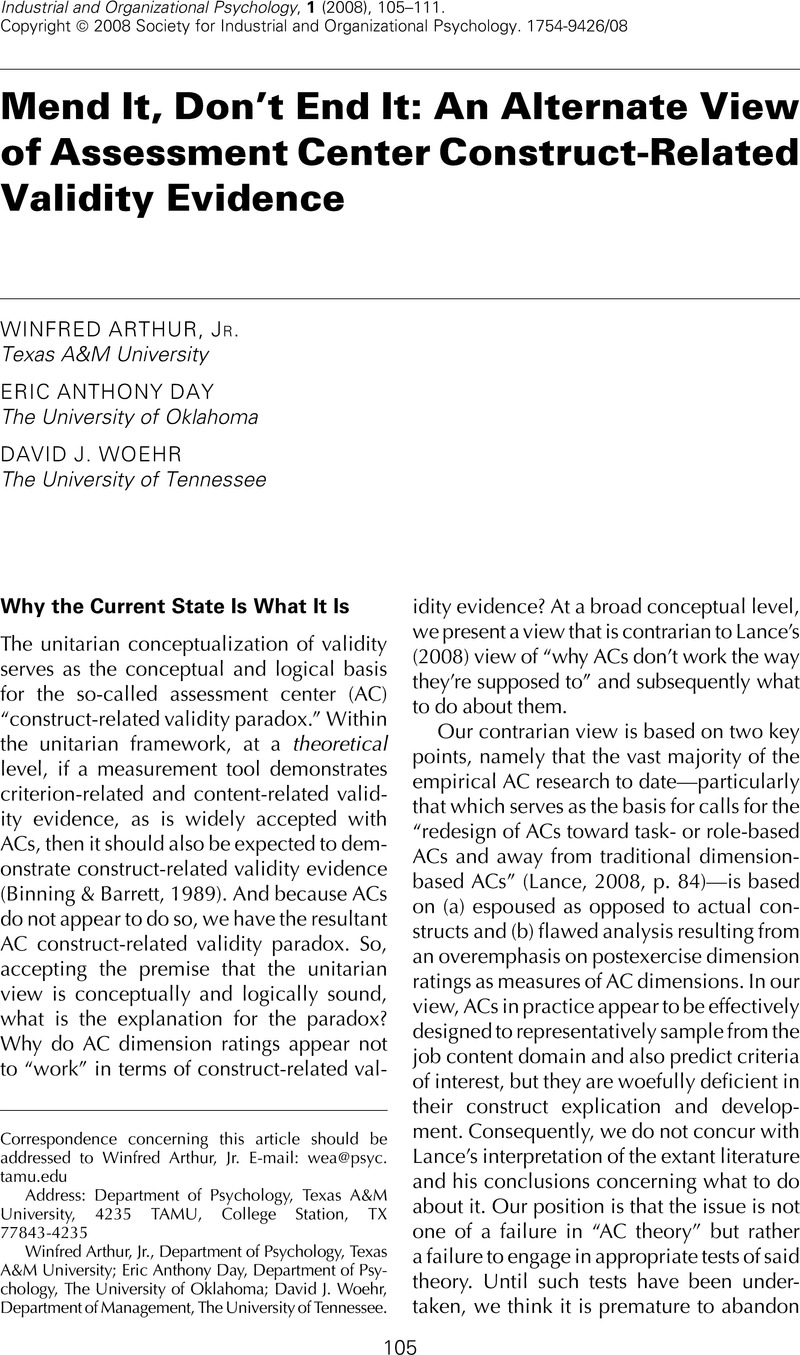Article contents
Mend It, Don’t End It: An Alternate View of Assessment Center Construct-Related Validity Evidence
Published online by Cambridge University Press: 07 January 2015
Abstract
An abstract is not available for this content so a preview has been provided. Please use the Get access link above for information on how to access this content.

- Type
- Commentaries
- Information
- Copyright
- Copyright © Society for Industrial and Organizational Psychology 2008
Footnotes
*
Department of Psychology, Texas A&M University
**
Department of Psychology, The University of Oklahoma
***
Department of Management, The University of Tennessee
References
American Educational Research Association, American Psychological Association, & National Council on Measurement in Education. (1999). Standards for educational and psychological testing. Washington, DC: American Educational Research Association.Google Scholar
Anastasi, A., & Urbina, S. (1997). Psychological testing (7th ed.). Upper Saddle River, NY: Prentice-Hall.Google Scholar
Arthur, W. Jr., Day, E. A., McNelly, T. L., & Edens, P. S. (2003). Meta-analysis of the criterion-related validity of assessment center dimensions. Personnel Psychology, 56, 125–154.Google Scholar
Arthur, W. Jr., & Villado, A. J. (in press). The importance of distinguishing between constructs and methods when comparing predictors in personnel selection research and practice. Journal of Applied Psychology.Google Scholar
Arthur, W. Jr., Woehr, D. J., & Maldegen, R. (2000). Convergent and discriminant validity of assessment center dimensions: An empirical re-examination of the assessment center construct-related validity paradox. Journal of Management, 26, 813–835.Google Scholar
Binning, J. F., & Barrett, G. V. (1989). Validity of personnel decisions: A conceptual analysis of the inferential and evidential bases. Journal of Applied Psychology, 74, 478–494.Google Scholar
Bowler, M. C., & Woehr, D. J. (2006). A meta-analytic evaluation of the impact of dimension and exercise factors on assessment center ratings. Journal of Applied Psychology, 91, 1114–1124.Google Scholar
Gasser, M., Butler, A., Waddilove, L., & Tan, R. (2004). Defining the profession of industrial-organizational psychology. Industrial-Organizational Psychologist, 42(2), 15–20.Google Scholar
Highhouse, S., & Zickar, M. J. (1997). Where has all the psychology gone?
Industrial-Organizational Psychologist, 35(2), 82–88.Google Scholar
Howard, A. (1997). A reassessment of assessment centers: Challenges for the 21st century. Journal of Social Behavior and Personality, 12, 13–52.Google Scholar
Lance, C. E. (2008). Why assessment centers do not work the way they are supposed to. Industrial Organizational Psychology: Perspectives on Science and Practice, 1, 84–97.Google Scholar
Lance, C. E., Woehr, D. J., & Meade, A. W. (2007). Case study: A Monte Carlo investigation of assessment center construct validity models. Organizational Research Methods, 10, 430–448.Google Scholar
Landy, F. J. (1986). Stamp collecting versus science: Validation as hypothesis testing. American Psychologist, 41, 1183–1192.Google Scholar
Lievens, F. (1998). Factors which improve the construct validity of assessment centers: A review. International Journal of Selection and Assessment, 6, 141–152.Google Scholar
Meriac, J. P., Hoffman, B. J., Fleisher, M., & Woehr, D. J. (2007, April). Expanding the nomological net surrounding assessment center dimensions: A meta-analysis. Paper presented at the 22nd Annual Conference of the Society for Industrial-Organizational Psychology, New York.Google Scholar
Messick, S. J. (1995). The validity of psychological assessment: Validation of inferences from persons’ responses and performances as scientific inquiry into score meaning. American Psychologist, 50, 741–749.Google Scholar
Nunnally, J. C., & Bernstein, I. H. (1994). Psychometric theory (3rd ed.). New York: McGraw-Hill.Google Scholar
Robie, C., Adams, K. A., Osburn, H. G., Morris, M. A., & Etchegaray, J. M. (2000). Effects of the rating process on the construct validity of assessment center dimension evaluations. Human Performance, 13, 355–370.Google Scholar
Ryan, A. M. (2003). Defining ourselves: I-O psychology’s identity quest. Industrial-Organizational Psychologist, 41(1), 21–33.Google Scholar
Sackett, P. R., & Dreher, G. F. (1982). Constructs and assessment center dimensions: Some troubling empirical findings. Journal of Applied Psychology, 67, 401–410.Google Scholar
Society for Industrial and Organizational Psychology, Inc. (2003). Principles for the validation and use of personnel selection procedures (4th ed.). Bowling Green, OH: SIOP.Google Scholar
Woehr, D. J., & Arthur, W. Jr. (2003). The construct-related validity of assessment center ratings: A review and meta-analysis of the role of methodological factors. Journal of Management, 29, 231–258.Google Scholar
Zedeck, S. (1986). A process analysis of the assessment center method. In Staw, B. & Cummings, L. (Eds.), Research in organizational behavior (Vol. 8, pp. 259–296). Greenwich, CT: JAI Press.Google Scholar
- 21
- Cited by


